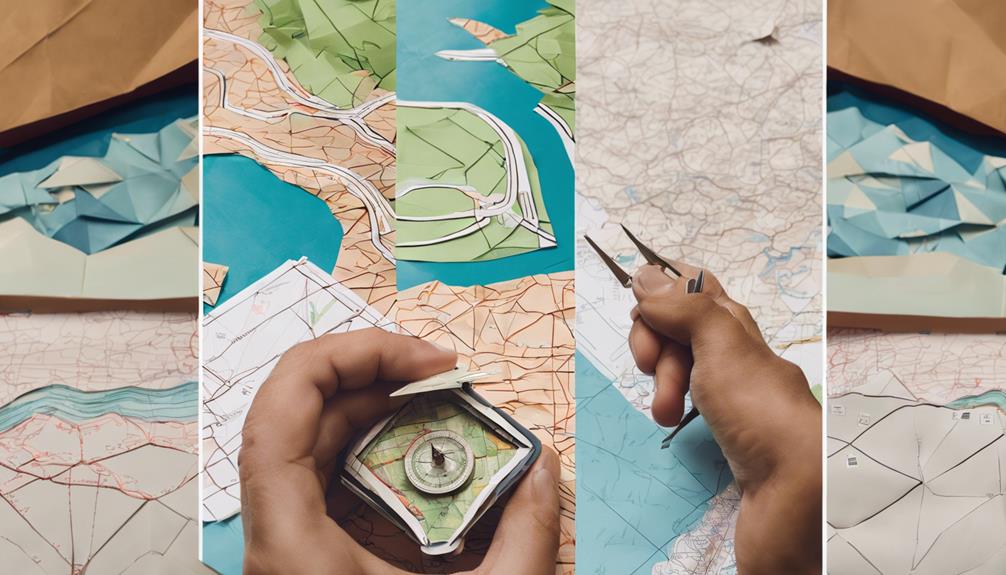General Rules of Adventure Racing Sport
As you embark on the world of adventure racing, it's essential to understand the general rules that govern this thrilling sport. You'll need to master course navigation, mandatory equipment requirements, and team composition to guarantee a successful race. Environmental responsibility, safety protocols, and medical clearance are also vital considerations. In addition, you'll need to grasp time penalties, penalties, and sportsmanship guidelines to maintain a positive and respectful attitude during the race. With these rules in mind, you'll be well-equipped to tackle even the toughest courses. As you explore the intricacies of adventure racing, you'll uncover even more secrets to success.
Course Design and Navigation

As you venture on an adventure racing journey, you'll quickly realize that course design and navigation are essential components that can make or break your performance. A well-designed course can push you to new heights, while a poorly planned one can leave you lost and frustrated. That's why checkpoint placement is pivotal. Strategically placed checkpoints can help you stay on track, providing a mental boost and a sense of accomplishment as you conquer each section. But it's not just about placing checkpoints anywhere – it's about optimizing the route to minimize detours and maximize your speed. Route optimization is an art that requires careful consideration of terrain, elevation, and obstacles. By finding the most efficient route, you'll be able to conserve energy and maintain a strong pace throughout the race. When done correctly, course design and navigation can be a game-changer, giving you the freedom to focus on your performance and push yourself to new limits. So, buckle up and get ready to take your adventure racing skills to the next level!
Mandatory Equipment Requirements
You'll need to pack a specific set of essentials to facilitate a safe and successful adventure racing experience, and that's where mandatory equipment requirements come in. These requirements are in place to safeguard you're prepared for any situation that may arise during the race. It's vital to understand what gear is required and how to pack it efficiently.
Gear checks will be conducted before the race to verify you have all the necessary equipment. Don't get caught off guard – make sure you've got everything on the list, from your helmet to your first-aid kit. Developing a solid packing strategy is key to a stress-free race day. Consider the terrain, weather, and length of the race when deciding what to pack. Remember, it's better to err on the side of caution and over-pack than to risk being unprepared. By understanding the mandatory equipment requirements, you'll be able to focus on what really matters – giving it your all and crossing that finish line.
Team Composition and Roles

As you assemble your adventure racing team, you'll need to weigh the essential roles that'll make or break your success. You'll need a navigator to chart your course, a athlete to drive your pace, and a support crew to keep you fueled and fixed. By understanding each role and its responsibilities, you'll be able to build a well-rounded team that's ready to take on the toughest challenges.
Team Structure
Your adventure racing team's structure is pivotal to success, with each member playing a pivotal role in traversing the challenging terrain and overcoming obstacles together. A well-structured team is like a well-oiled machine, where each cog works in harmony to achieve a common goal. When it comes to team dynamics, a cohesive unit is essential. You'll need to assess each member's strengths, weaknesses, and personality traits to create a balanced team. This will help you identify potential conflicts and work towards resolving them before they escalate.
Effective leadership styles are also vital in adventure racing. You'll need a leader who can make quick, informed decisions, and communicate them clearly to the team. A good leader will empower team members, encourage open communication, and foster a positive team culture. When everyone feels valued and heard, morale boosts, and the team becomes more resilient. By understanding team dynamics and adopting an effective leadership style, you'll be well on your way to building a high-performing team that's ready to take on any adventure racing challenge that comes your way.
Racing Roles Defined
In a well-balanced adventure racing team, each member's unique strengths and skills are leveraged to fill distinct roles that, when combined, form a formidable unit capable of conquering the toughest challenges. As you assemble your team, recognizing each member's racing archetype, understanding their strengths, weaknesses, and motivations is crucial. You'll likely find that your teammates embody one or more of the following archetypes: the navigator, the powerhouse, the strategist, and the motivator.
When you understand each other's strengths, you can optimize your team dynamics. You'll learn to rely on the navigator's route-finding skills, the powerhouse's endurance, the strategist's tactical mind, and the motivator's infectious enthusiasm. By acknowledging and embracing these roles, you'll create a cohesive unit that's greater than the sum of its parts. Effective team dynamics rely on open communication, active listening, and mutual respect. As you work together, you'll develop a deep understanding of each other's strengths and weaknesses, allowing you to adapt and overcome any obstacle that comes your way. By embracing your racing archetype and working together, you'll tap your team's full potential and conquer even the most demanding adventure racing challenges.
Crew Responsibilities
You've assembled your team, now it's time to define crew responsibilities and allocate roles to guarantee each member's strengths are maximized and weaknesses minimized. Clear definition of roles ensures seamless collaboration, efficient task management, and optimal performance.
Effective crew responsibilities hinge on three key aspects:
- Communication Strategies: Establish open and transparent communication channels to ensure that each member is informed and aligned with the team's objectives.
- Task Delegation: Identify each member's strengths and allocate tasks that play to those strengths, ensuring that each member is working efficiently and effectively.
- Role Definition: Clearly define each member's role, including navigator, pace-setter, and support member, to avoid confusion and overlapping responsibilities.
Time Penalties and Penalties
During adventure racing events, organizers often impose time penalties and penalties on teams that fail to comply with course rules or regulations, substantially impacting their overall performance and standings. You should be aware that these penalties can make a significant difference in the outcome of the race. A well-established penalty system maintains fairness and accountability among teams, promoting a culture of responsibility and respect for the rules.
As you navigate the course, understanding the penalty systems in place is vital. Time penalties can range from a few minutes to several hours, depending on the severity of the infraction. Repeated offenses can lead to disqualification, so familiarizing yourself with the rules and regulations is key. A penalty culture that values accountability and transparency helps maintain the integrity of the sport, guaranteeing that all teams have an equal opportunity to succeed. By understanding the penalty systems and adhering to the rules, you'll be able to focus on what matters most – pushing yourself to new limits and achieving victory.
Environmental Responsibility

As you push yourself to new limits in adventure racing, you're not just racing against other teams – you're also racing against the clock to minimize your environmental footprint. As an adventure racer, you have a unique opportunity to make a positive impact on the environments you explore.
Here are three ways to prioritize environmental responsibility in your racing:
- Reduce waste: Refrain from littering and avoid single-use plastics. Bring reusable water bottles, containers, and bags to minimize your trash output.
- Choose eco-friendly gear: Opt for sustainable, eco-friendly gear and apparel that are made from environmentally responsible materials.
- Respect natural habitats: Be mindful of protected areas and wildlife habitats. Avoid disturbing or damaging natural environments, and take all necessary precautions to prevent forest fires.
Safety Protocols and Procedures
In adventure racing, your safety is paramount, so it's crucial that you're well-versed in essential safety protocols and procedures to minimize risks and respond effectively in emergency situations. As you prepare for your next adventure, remember that risk assessment is key. Identify potential hazards and take steps to mitigate them. Conduct thorough safety briefings with your team to guarantee everyone's on the same page. In the event of an emergency, have a clear emergency response plan in place, including first aid procedures and evacuation strategies. Don't underestimate the importance of hazard identification – be aware of your surroundings and take necessary precautions to avoid accidents. By prioritizing safety, you'll be free to focus on the thrill of the race, unencumbered by unnecessary worry. So, take the time to review and rehearse safety protocols, and you'll be ready to tackle even the most demanding adventure racing courses with confidence.
Medical Clearance and Insurance

Before you hit the starting line, make sure you've got the green light from your doctor and the right insurance coverage to protect yourself and your team from financial and medical risks. As an adventure racer, you know that anything can happen out there, and it's crucial to be prepared.
First, get a thorough medical check-up to ensure you're fit for the challenge. Share your Medical History with your doctor, and ask about any concerns or risks associated with your participation.
Here are three essential things to consider for your insurance coverage:
- Accident Insurance: Covers medical expenses in case of an accident during the race.
- Liability Insurance: Protects you and your team in case of damage to third-party property or injury to others.
- Trip Cancellation Insurance: Reimburses you if you need to cancel or postpone your trip due to unforeseen circumstances.
Don't take unnecessary risks – get the right insurance options to safeguard your adventure. With the right medical clearance and insurance coverage, you'll be free to focus on the thrill of the race!
Race Conduct and Sportsmanship
As you prepare to set out on an adventure race, remember that you're not just competing against others, you're also part of a community that values respect and fair play. You'll be expected to treat fellow racers with kindness and consideration, and to conduct yourself in a way that honors the spirit of the sport. By doing so, you'll not only enhance your own experience, but also contribute to a positive and supportive racing environment.
Respect for Fellow Racers
Your reputation as an adventure racer is built on more than just your performance; it's also founded on the respect you show fellow racers. You're not just competing against others, you're part of a community that values camaraderie and mutual respect. As you navigate the challenging terrain, remember that your behavior on the course reflects not only on you, but also on the sport as a whole.
Here are three key aspects of respecting your fellow racers:
- Racer Etiquette: Be mindful of your trash and make sure to pack out what you pack in. This not only keeps the environment clean but also shows respect for the land and other racers.
- Sportsmanship Guidelines: Congratulate fellow racers on their achievements and offer words of encouragement when they're struggling. A simple "good job" or "keep going" can go a long way in building a positive and supportive community.
- Course Courtesy: Be aware of your surroundings and yield to faster racers when necessary. This helps maintain a smooth flow of traffic and prevents unnecessary congestion on the course.
Fair Play Expectations
Fair play is the cornerstone of adventure racing, and you're expected to embody the highest standards of integrity, honesty, and respect for the rules and your fellow competitors. As you set out on this thrilling journey, remember that sportsmanship codes are in place to maintain a level playing field for all. You're expected to respect these codes and adhere to the ethical boundaries that govern our sport.
In adventure racing, you'll encounter challenging situations that'll test your resolve and character. It's how you respond to these situations that'll define you as a competitor. Will you take shortcuts or bend the rules to gain an advantage? Or will you choose to uphold the values of fair play, even when it's difficult? The choice is yours, but remember, your actions have consequences. By upholding the principles of sportsmanship, you'll earn the respect of your peers and contribute to a positive, supportive community.
As you navigate the course, remember that fair play isn't just about winning – it's about the way you win. So, stay true to the spirit of adventure racing, and let your integrity shine through in every decision you make.
Frequently Asked Questions
Can I Participate in an Adventure Race With a Physical Disability?
"You can totally participate in an adventure race with a physical disability! Look for events offering accessible routes and consider adaptive equipment to help you navigate the course – you got this!"
Do Adventure Races Have Age Restrictions for Participants?
Get ready to tap into your inner adventurer! You'll find age restrictions vary by race, but most offer Youth divisions, with minimum ages (typically 12-15) and age waivers for Junior racers – so don't let age hold you back!
Can I Use a GPS Device to Navigate the Course?
You're free to use a GPS device to navigate the course, but don't rely solely on it – combine with map skills for effective Route Optimization and Course Calibration, ensuring Map Accuracy and Device Reliability, as you master Navigation Strategies!
Are Spectators Allowed to Follow the Race Route?
As you cheer on your favorite racers, remember that spectators aren't allowed to follow the race route to prevent Route Closure and guarantee participant safety, but Volunteer Escorts will guide you to designated viewing areas!
Can I Withdraw From the Race and Get a Refund?
"Hey, if you need to withdraw from the race, don't stress! Check your Race Insurance policy, and review the Refund Policy – you might be eligible for a refund, and we'll help you navigate the process, no worries!"






